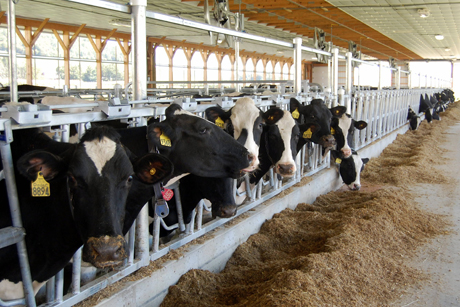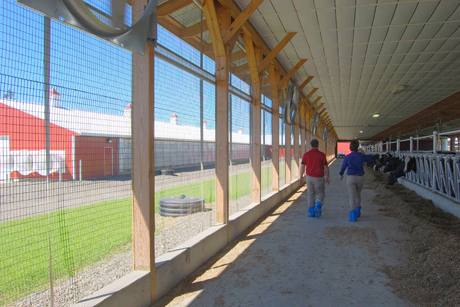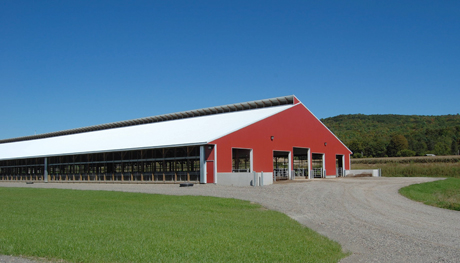New barn makes cows – and researchers – happier
By Stacey Shackford



Life’s a beach for Frosty, Junior, Pancho and the 547 other cows who have moved into their new $8 million, 105,000-square-foot home in Harford, N.Y., in a bucolic setting 15 miles from campus.
They have traded their former cramped accommodation in a stuffy, 40-year-old cinderblock facility for roomy stalls featuring deep beds of soft sand and lots of light and fresh air.
Researchers are also rejoicing. The new college-funded Cornell University Ruminant Center – which opened in September after a year of construction – features basic and state-of-the art upgrades that will make it easier for faculty, staff and students to conduct research on nutrient use that has implications for environmental efficiency, reproduction and dairy cattle health and well-being.
“We now better reflect what our progressive dairies are doing, from a facilities standpoint,” said animal science professor Tom Overton ’91. “This gives us an opportunity to focus attention on the needs at both the farm level and within the industry across New York.”
It may also provide new research opportunities. Group (freestall) housing, for instance, is common in many New York dairies but not in research facilities. In addition to individual tie stalls, the new Harford barn has sections where cows can be housed in groups of 16 or 32, which will allow researchers to study aspects of dairy cattle management in group-housed cows for the first time.
It also has a milking parlor with an underground sampling area, and separate weigh stations, holding pens and “metabolism stalls,” where additional space around each stall allows for more intensive study of nutrient digestion and cow physiology.
“Our focus was creating a facility that is modern in design, with high levels of cow comfort, efficient from an operational standpoint, with a lot of functionality to do the types of research that we think are important to help our dairy farmers continue to innovate,” Overton said.
Katie Schoenberg ’03, Ph.D. ’11, who conducted her Ph.D. research in the old 1971-era Teaching and Research Center, said the new facility will be a great asset to the university and to the dairy industry. In her new role as a research scientist for Elanco Animal Health based in Greenfield, Ind., Schoenberg relies heavily on the expertise of faculty in her former department, and she said that the new facility will enhance opportunities for further collaboration.
“This is a top-notch facility. There are not many like it across the country, and it reinforces Cornell’s role as a leading institution in dairy cattle research,” Schoenberg said. “This is going to have a huge impact on students and researchers in the department.”
Stacey Shackford is a writer for the College of Agriculture and Life Sciences.
Get Cornell news delivered right to your inbox.
Subscribe